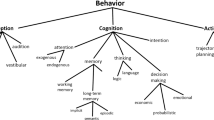Abstract
In this paper, we connected Zeno’s paradoxes and motions with the viscous friction force \(F=-bv\). For the progressive version of the dichotomy paradox, if the body speed is constant, the sequences of positions and instants are infinite, but the series of distances and time variations converge to finite values. However, when the body moves with force \(F=-bv\), the series of time variations becomes infinite. In this case, the body crosses infinite points, approximating to a final position forever, as the progressive version of the dichotomy paradox describes. The same procedures with constant speed and motion with force \(F =-bv\) result in different spatial sequences and the same series for the regressive version of the dichotomy paradox. Nonetheless, the regressive version of the dichotomy paradox does not describe a body that approximates a final position forever. Finally, for the Achilles paradox, we find the positional and temporal sequences of the man and the tortoise at constant speeds. Analogously to the progressive version of the dichotomy paradox, the positional and temporal sequences are infinite, but the spatial and temporal series converge to finite values. If Achilles and the tortoise are identical points that move with force \(F=-bv\), and the turtle’s position in function of time presents a temporal advantage, the man and the animal will cross successive infinite places forever, and the quick hero will never overtake the slow reptile, as the paradox described. We conclude that the progressive version of the dichotomy and Achilles paradoxes can describe motions when the force is \(F =-bv\).
Similar content being viewed by others
References
Palmer, J.: "Zeno of Elea", The Stanford Encyclopedia of Philosophy (Spring 2017 edn), Zalta, E.N. (ed.). https://plato.stanford.edu/archives/spr2017/entries/zeno-elea/
Bradley, D.: "Zeno’s Paradoxes", The Stanford Encyclopedia of Philosophy (Spring 2017 edn.), Zalta, E.N. (ed.). https://plato.stanford.edu/entries/paradox-zeno/
Palmer, J.: "Parmenides", The Stanford Encyclopedia of Philosophy (Winter 2016 edn.), Zalta, E.N. (ed.). https://plato.stanford.edu/entries/parmenides/
Antopolous, C.: Moving without being where you’re not; a non-bivalent way. J. Gen. Philos. Sci. 35, 235–259 (2004). https://doi.org/10.1515/apeiron-2016-0069
Bushwick, N.L.: Extracting a Paradox by the Roots. https://arxiv.org/ftp/arxiv/papers/1411/1411.4869.pdf
McLaughlin, W., Miller, S.L.: An epistemological use of nonstandard analysis to answer Zeno’s objections against motion. Synthese 92, 371–384 (1992)
Calenda, G.: Are Zeno’s arguments unsound paradoxes? Peitho. Examina Antiqua 4, 125–140 (2013)
Cohoe, C.: Why continuous motions cannot be composed of sub-motions: aristotle on change, rest, and actual and potential middles. Apeiron 51, 37–71 (2018). https://doi.org/10.1515/apeiron-2016-0069
Alper, J.S., Bridger, M.: Mathematics, models, and Zeno’s paradoxes of motion. Synthese 110, 143–166 (1997)
Stefanov, A.S.: Zeno’s paradoxes revisited. Logos Episteme 3, 319–335 (2013)
Papa-Grimaldi, A.: Why mathematical solutions of Zeno’s paradoxes miss the point: Zeno’s one and many relation and parmenides’ prohibition. Rev. Metaphys. 50(2), 299–314 (1996)
Hemming, L.P.: The place of Zeno’s paradox. Environ. Plan. D 29, 924–937 (2011)
Glazebrook, T.: Zeno against mathematical physics. J. Hist. Ideas 62(2), 193–210 (2001)
Key, J.A.: Russell on Zeno’s paradoxes. Early 20th century analytic philosophy. https://www.academia.edu/43923483/
Russell, B.: Our Knowledge of the External World: As a Field for Scientific Method in Philosophy. Routledge, London (1914)
Bathfield, M.: Why Zeno’s paradoxes of motion are actually about immobility. Found. Sci. 23, 649–679 (2018)
Dietrich, E.: When science confronts philosophy: three case studies. Axiomathes 30(5), 479–500 (2020). https://doi.org/10.1007/s10516-019-09472-9
Allen, B.W.: Zeno, Aristotle, the Racetrack and the Achilles: A Historical and Philosophical Investigation. NOOKstudy eTextbook, ISBN: 9781109058437
Lynds, P.: Time and classical and quantum mechanics: indeterminacy vs. discontinuity. Found. Phys. Lett. 16(4), 343–355 (2003)
Fixelle, J., Johnson, K.A.: Longitudinal light clock and Zeno’s paradox. Am. J. Undergrad. Res. 9, 13–17 (2010)
Home, D.: A conceptual analysis of quantum Zeno; paradox, measurement, and experiment. Ann. Phys. 258, 237–285 (1997)
Jaroszkiewicz, G., Eakins, J.: Particle decay processes, the quantum Zeno eect and the continuity of time. (2006). http://arXiv.org/abs/quant-ph/0608248v2
Vaknin, D.S.: Chronons, time atoms, and quantized time: time asymmetry re-visited. EPH Int. J. Appl. Sci. 4(9), 06–11 (2018)
Ardourel, V.: A discrete solution for the paradox of achilles and the tortoise. Synthese 192(9), 2843–286 (2015)
Grünbaum, A.: Modern science and Zeno’s paradoxes. Wesleyan University Press, Middletown, CN (1967)
Andraus, A.: Zeno-machines and the metaphysics of time. Unisinos J. Philos. 17(2), 161–167 (2016). https://doi.org/10.4013/fsu.2016.172.11
Sattler, B.M.: The labours of Zeno—a Supertask indeed?. Ancient Philosophy Today (2019)
Manchak, J.B., Roberts, B.W.: "Supertasks", The Stanford Encyclopedia of Philosophy (Winter 2016 edn), Zalta, E.N. (ed.) https://plato.stanford.edu/archives/win2016/entries/spacetime-supertasks/
Salmon, W. (ed.): Zeno’s Paradoxes. Hackett, Indianapolis, Cambridge (2001)
Maxemow, S.: That’s a drag: the effects of drag forces. Undergrad. J. Math. Model. 2(1), 4 (2009). https://doi.org/10.5038/2326-3652.2.1.4
Author information
Authors and Affiliations
Corresponding author
Additional information
Publisher's Note
Springer Nature remains neutral with regard to jurisdictional claims in published maps and institutional affiliations.
Rights and permissions
About this article
Cite this article
dos Santos, L.S.F. Zeno’s Paradoxes and the Viscous Friction Force. Found Phys 52, 67 (2022). https://doi.org/10.1007/s10701-022-00589-3
Received:
Accepted:
Published:
DOI: https://doi.org/10.1007/s10701-022-00589-3




